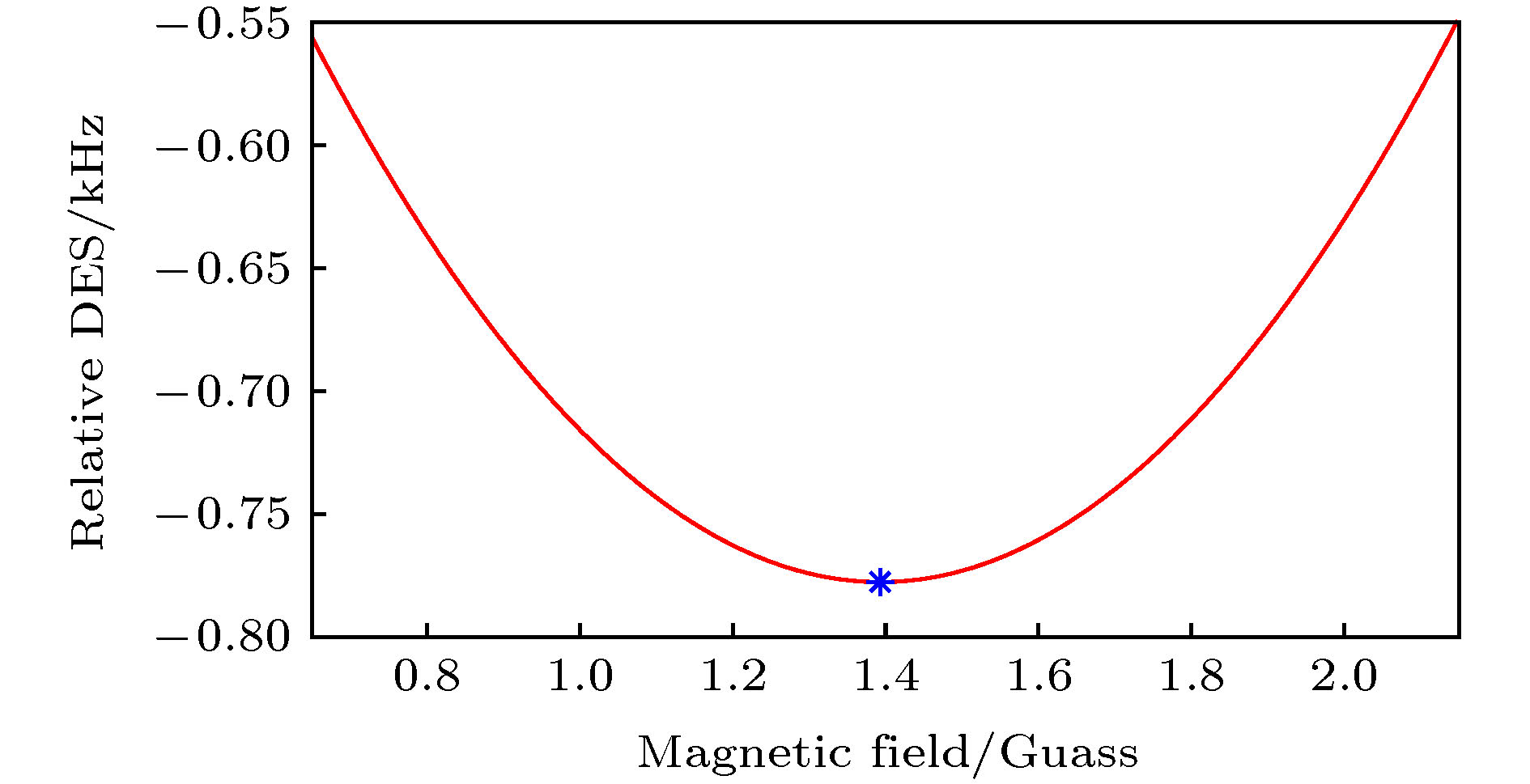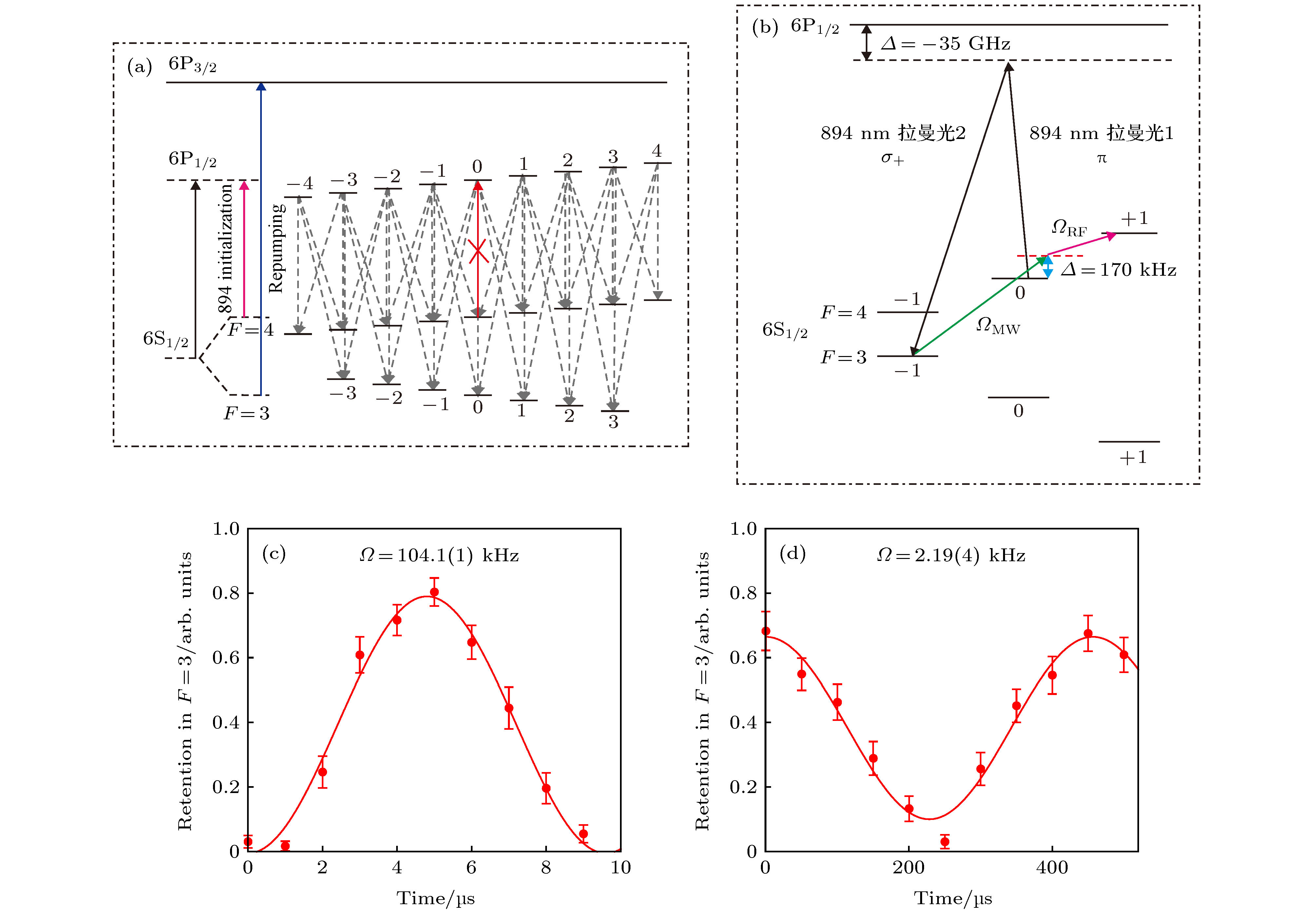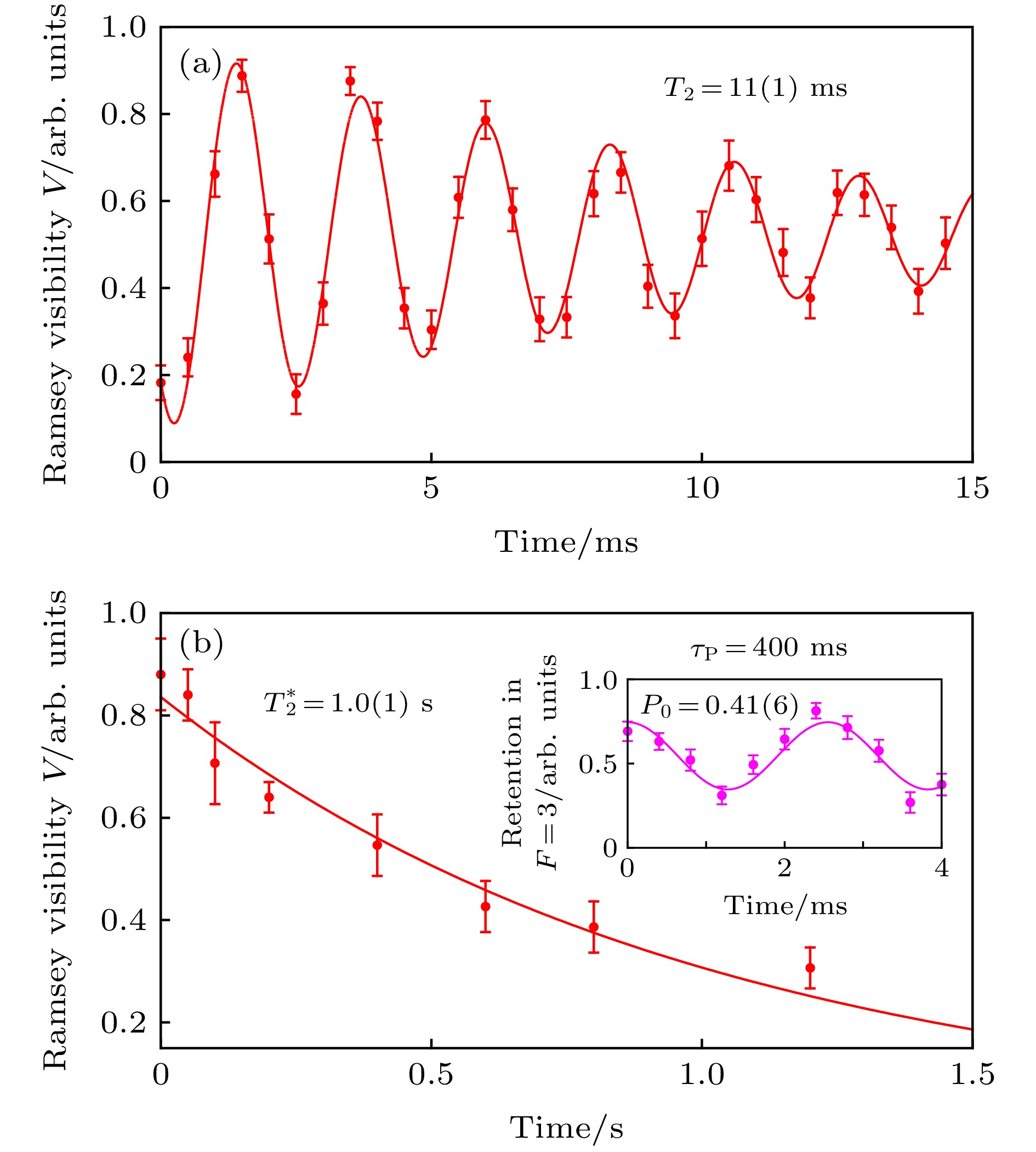-
单个中性原子的超精细微波跃迁能级的相干性是基于中性原子量子计算、量子信息处理和量子模拟的基础. 我们在实验上利用微波双光子拉曼过程实现了蓝移阱中铯原子基态超精细态
$\left| {{\rm{6}}{{\rm{S}}_{1/2}},F = 3,{m_F} = - 1} \right\rangle $ 和$\left| {{\rm{6}}{{\rm{S}}_{1/2}},F = 4,{m_F} = 1} \right\rangle $ 间的相干操控, 并研究了其相对能级频移随磁场的变化, 获得了“魔术”磁场的大小为1.4(2) Gauss (1 Gauss = 10-4 T). 结果表明, 利用魔术磁场可大幅改善超精细态$\left| {\rm{6}}{{\rm{S}}_{1/2}}\right.$ ,$F = 3 $ ,$\left. {m_F} = - 1 \right\rangle $ 和$\left| {{\rm{6}}{{\rm{S}}_{1/2}},F = 4,{m_F} = 1} \right\rangle $ 之间的相干性, 测量到的相干时间可达1.0(1) s.Qubit encoded in single neutral atoms is a basic experimental platform for studying the quantum computation, quantum information processing and quantum simulation. The extension of the coherence time has been an important task in recent years. On the basis of the single cesium neutral atom trapped in blued-detuned dipole trap, we study the coherence time of a qubit, which is encoded in a pair of magnetically insensitive ground states of cesium atom ($\left| {\rm{0}} \right\rangle = \left| {{\rm{6}}{{\rm{S}}_{1/2}},F = 3,{m_F} = - 1} \right\rangle $ and$\left| 1 \right\rangle = \left| {{\rm{6}}{{\rm{S}}_{1/2}},F = 4,{m_F} = + 1} \right\rangle $ ), in the “magic” magnetic field condition. By adopting a two-photon process, in which a microwave photon and an RF photon are used, we obtain the coherence manipulation of the qubit. The dependence of differential energy shift on magnetic field is experimentally studied, and the “magic” magnetic field is determined. In this magic condition, the first derivative of differential energy shift between$\left| {\rm{0}} \right\rangle = \left| {{\rm{6}}{{\rm{S}}_{1/2}},F = 3,{m_F} = - 1} \right\rangle $ and$\left| 1 \right\rangle = \left| {{\rm{6}}{{\rm{S}}_{1/2}},F = 4,{m_F} = + 1} \right\rangle $ in quantized magnet field is zero, which means that the qubit is immune to the fluctuation of magnetic field and the coherence time can be substantially prolonged. The experimentally obtained magic magnetic field is B = 1.4(2) Gauss, which is in good agreement with the theoretical calculation value B = 1.393 Gauss. Finally, we measure the qubit coherence time by setting the quantized magnetic field to be at magic point B = 1.396 Gauss. The qubit coherence time is measured to be 11(1) ms by Ramsey interferometer, where the main decoherence factor is the inhomogeneous dephasing due to the atomic motion in the dipole trap. This incoherence factor can be dramatically suppressed by a spin-echo process where an additional π-pulse is inserted in between the two π/2 pulses. At the magic magnetic point the qubit coherence time can be extended to 1 s by the spin-echo method.[1] Divincenzo D P 2001 Quantum Comput. 1 1
[2] García-Ripoll J J, Zoller P, Cirac J I 2003 Phys. Rev. Lett. 91 157901
 Google Scholar
Google Scholar
[3] Loss D, Divincenzo D P 1998 Phys. Rev. A 57 120
 Google Scholar
Google Scholar
[4] Kennedy T A, Charnock F T, Colton J S, Butler J E, Linares R C, Doering P J 2002 Phys. Status Sollidi 233 416
 Google Scholar
Google Scholar
[5] Porto J V, Rolston S, Laburthe Tolra B, Williams C J, Phillips W D 2003 Philos. Trans. Roy. Soc. Lond. A 361 1417
 Google Scholar
Google Scholar
[6] Saffman M 2019 Natl. Sci. Rev. 6 24
 Google Scholar
Google Scholar
[7] Weiss D S, Saffman M 2017 Phys. Today 70 44
[8] Saffman M, Walker T G, Mølmer K 2010 Rev. Mod. Phys. 82 2313
 Google Scholar
Google Scholar
[9] Barredo D, Lienhard V, de Léséleuc S, Lahaye T, Browaeys A 2018 Nature 561 79
 Google Scholar
Google Scholar
[10] Endres M, Bernien H, Keesling A, Levine H, Anschuetz E R, Krajenbrink A, Senko C, Vuletic V, Greiner M, Lukin M D 2016 Science 354 1024
 Google Scholar
Google Scholar
[11] Barredo D, de Léséleuc S, Lienhard V, Lahaye T, Browaeys A 2016 Science 354 1021
 Google Scholar
Google Scholar
[12] Xia T, Lichtman M, Maller K, Carr A W, Piotrowicz M J, Isenhower L, Saffman M 2015 Phys. Rev. Lett. 114 100503
 Google Scholar
Google Scholar
[13] Wang Y, Kumar A, Wu T Y, Weiss D S 2016 Science 352 1562
 Google Scholar
Google Scholar
[14] Sheng C, He X D, Xu P, Guo R J, Wang K P, Xiong Z Y, Liu M, Wang J, Zhan M S 2018 Phys. Rev. Lett. 121 240501
 Google Scholar
Google Scholar
[15] Levine H, Keesling A, Semeghini G, Omran A, Wang T T, Ebadi S, Bernien H, Greiner M, Vuletić V, Pichler H, Lukin M D 2019 Phys. Rev. Lett. 123 170503
 Google Scholar
Google Scholar
[16] Graham T M, Kwon M, Grinkemeyer B, Marra Z, Jiang X, Lichtman M T, Sun Y, Ebert M, Saffman M 2019 arXiv: 1908.061003 [quant-ph]
[17] Wang Y, Um M, Zhang J H, An S M, Lyu M, Zhang J N, Duan L M, Yum D, Kim K 2017 Nat. Photonics 11 646
 Google Scholar
Google Scholar
[18] Derevianko A, Katori H 2011 Rev. Mod. Phys. 83 331
 Google Scholar
Google Scholar
[19] Flambaum V V, Dzuba V A, Derevianko A 2008 Phys. Rev. Lett. 101 220801
 Google Scholar
Google Scholar
[20] Katori H, Hashiguchi K, Il'Inova E Y, Ovsiannikov V D 2009 Phys. Rev. Lett. 103 153004
 Google Scholar
Google Scholar
[21] Carr A W, Saffman M 2016 Phys. Rev. Lett. 117 150801
 Google Scholar
Google Scholar
[22] Choi J M, Cho D 2007 J. Phys. Conf. Ser. 80 012037
 Google Scholar
Google Scholar
[23] Derevianko A 2010 Phys. Rev. Lett. 105 033002
 Google Scholar
Google Scholar
[24] Li G, Tian Y L, Wu W, Li S K, Li X Y, Liu Y X, Zhang P F, Zhang T C 2019 Phys. Rev. Lett. 123 253602
 Google Scholar
Google Scholar
[25] Kim H, Han H S, Cho D 2013 Phys. Rev. Lett. 111 243004
 Google Scholar
Google Scholar
[26] Yang J H, He X D, Guo R J, Xu P, Wang K P, Sheng C, Liu M, Wang J, Derevianko A, Zhan M S 2016 Phys. Rev. Lett. 117 123201
 Google Scholar
Google Scholar
[27] Tian Y L, Wang Z H, Yang P F, Zhang P F, Li G, Zhang T C 2019 Chin. Phys. B 28 023701
 Google Scholar
Google Scholar
[28] Alkali D Line Data, Steck D A http://steck.us/alkalidata/ [2019-12-13]
[29] 王建龙, 李刚, 田亚莉, 张天才 2015 量子光学学报 21 74
Wang J L, Li G, Tian Y L, Zhang T C 2015 Journal of Quantum Optics 21 74
-
图 1 铯原子超精细态
$\left| {{\rm{6}}{{\rm{S}}_{1/2}}, F = 3, {m_F} = - 1} \right\rangle $ 和$\left|{\rm{6}}{{\rm{S}}_{1/2}}\right.$ , F = 4,$\left.{m_F} = 1 \right\rangle $ 的相对差分频移随磁场变化, 其中蓝色点表示魔术磁场Fig. 1. The relative DES (differential energy shift) between cesium hyperfine states
$\left| {{\rm{6}}{{\rm{S}}_{1/2}}, F = 3, {m_F} = - 1} \right\rangle $ and$\left| {{\rm{6}}{{\rm{S}}_{1/2}}, F = 4, {m_F} = 1} \right\rangle $ functional relationship with the magnetic field. The blue star indicates the magic magnetic field.图 3 光学抽运实现态初始化
$\left| {F = 4, {m_F} = 0} \right\rangle $ 制备以及量子比特$\left| {{\rm{6}}{{\rm{S}}_{1/2}}, F = 4, {m_F} = {\rm{0}}} \right\rangle $ 和$\left| {{\rm{6}}{{\rm{S}}_{1/2}}, F = 3, {m_F} = - 1} \right\rangle $ 之间的相干转移 (a)初始化$\left| {F = 4, {m_F} = 0} \right\rangle $ 原理图; (b)双光子拉曼过程中量子比特$\left| {\rm{0}} \right\rangle = \left| {F = 3, {m_F} = - 1} \right\rangle $ 的制备以及利用双光子共振过程实现量子比特$\left| {6{{\rm{S}}_{1/2}}, F = 3, {m_F} = - 1} \right\rangle \leftrightarrow \left| {6{{\rm{S}}_{1/2}}, F = 4, {m_F} = + 1} \right\rangle $ 的相干转移; (c)$\left| {{\rm{6}}{{\rm{S}}_{1/2}}, F = 4, {m_F} = {\rm{0}}} \right\rangle $ 和$\left|{\rm{6}}{{\rm{S}}_{1/2}}\right.$ , F = 3,$\left.{m_F} = - 1 \right\rangle $ 的拉比振荡; (d)$\left| {6{{\rm{S}}_{1/2}}, F = 3, {m_F} = - 1} \right\rangle \leftrightarrow \left| {6{{\rm{S}}_{1/2}}, F = 4, {m_F} = + 1} \right\rangle $ 的拉比振荡Fig. 3. (a) Energy scheme for initialization of Zeeman state
$\left| {F = 4, {m_F} = 0} \right\rangle $ by optical pumping; (b) the preparation of qubit$\left| {\rm{0}} \right\rangle = \left| {F = 3, {m_F} = - 1} \right\rangle $ through two-photon Raman transition.$\varDelta $ is the intermediate state detuning from the excited state$6{P_{1/2}}$ ; (c) two-photon Raman Rabi oscillations on the$\left| {{\rm{6}}{{\rm{S}}_{1/2}}, F = 4, {m_F} = {\rm{0}}} \right\rangle \leftrightarrow \left| {{\rm{6}}{{\rm{S}}_{1/2}}, F = 3, {m_F} = - 1} \right\rangle $ transition. The red solid line is fits to a Rabi sinc function; (d) two-photon Raman Rabi oscillations on the$\left| {6{{\rm{S}}_{1/2}}, F = 3, {m_F} = - 1} \right\rangle \leftrightarrow \left|6{{\rm{S}}_{1/2}}\right.$ , F = 4,$\left. {m_F} = + 1 \right\rangle $ transition. The oscillation is a fit according to cosine function. Each point is the statistics over 100 shoots.图 4
$\left| {6{{\rm{S}}_{1/2}}, F = 3, {m_F} = - 1} \right\rangle $ 与$\left| {6{{\rm{S}}_{1/2}}, F = 4, {m_F} = + 1} \right\rangle $ 的能级间隔随磁场变化, 实线为公式拟合. 插图为对应磁场为1.233 Gauss时的拉曼谱, 纵坐标频率相对频移为$\Delta {\upsilon _{{\rm{DLS}}}} = $ –1.957(4) kHzFig. 4. The relative DES between states
$\left|6{{\rm{S}}_{1/2}}\right., F = 3, $ $\left. {m_F} = - 1 \right\rangle $ and$\left| {6{{\rm{S}}_{1/2}}, F = 4, {m_F} = + 1} \right\rangle $ , solid line is the functional fitting. Inset is the Raman spectrum measured at B = 1.233 Gauss, the relative offset of spectrum is$\Delta {\upsilon _{{\rm{DLS}}}} =$ –1.957(4) kHz.图 5 相干时间测量结果 (a) Ramsey干涉测量量子比特的退相干时间为11(1) ms; (b)干涉图样的振幅随自旋回波时间的变化, 退相干时间延长为1.0(1) s, 利用衰减的e指数对归一化实验数据进行拟合, 插图为自由演化时间为400 ms时对应的自旋回波干涉图样, 幅值为0.41(6)
Fig. 5. Experimental results for the coherence time measurements: (a) The Ramsey spectrum. The fitting by
$P = \dfrac{{{P_0}}}{2}{{\rm{e}}^{ - \frac{t}{{{T_2}}}}}\cos \left( {2{\text{π}}\varOmega t + \phi } \right)$ gives the coherence time$\left( {{T_2}} \right)$ of 11(1) ms; (b) the decay of the amplitude of spin echo signal. The exponential fitting (solid line) gives a coherence time of$T_2^* = 1.0(1)\;{\rm{s}}$ . Insert is the spin echo signal at evolution time of${\tau _{\rm{p}}} = {\rm{4}}00\;{\rm{ms}}$ . -
[1] Divincenzo D P 2001 Quantum Comput. 1 1
[2] García-Ripoll J J, Zoller P, Cirac J I 2003 Phys. Rev. Lett. 91 157901
 Google Scholar
Google Scholar
[3] Loss D, Divincenzo D P 1998 Phys. Rev. A 57 120
 Google Scholar
Google Scholar
[4] Kennedy T A, Charnock F T, Colton J S, Butler J E, Linares R C, Doering P J 2002 Phys. Status Sollidi 233 416
 Google Scholar
Google Scholar
[5] Porto J V, Rolston S, Laburthe Tolra B, Williams C J, Phillips W D 2003 Philos. Trans. Roy. Soc. Lond. A 361 1417
 Google Scholar
Google Scholar
[6] Saffman M 2019 Natl. Sci. Rev. 6 24
 Google Scholar
Google Scholar
[7] Weiss D S, Saffman M 2017 Phys. Today 70 44
[8] Saffman M, Walker T G, Mølmer K 2010 Rev. Mod. Phys. 82 2313
 Google Scholar
Google Scholar
[9] Barredo D, Lienhard V, de Léséleuc S, Lahaye T, Browaeys A 2018 Nature 561 79
 Google Scholar
Google Scholar
[10] Endres M, Bernien H, Keesling A, Levine H, Anschuetz E R, Krajenbrink A, Senko C, Vuletic V, Greiner M, Lukin M D 2016 Science 354 1024
 Google Scholar
Google Scholar
[11] Barredo D, de Léséleuc S, Lienhard V, Lahaye T, Browaeys A 2016 Science 354 1021
 Google Scholar
Google Scholar
[12] Xia T, Lichtman M, Maller K, Carr A W, Piotrowicz M J, Isenhower L, Saffman M 2015 Phys. Rev. Lett. 114 100503
 Google Scholar
Google Scholar
[13] Wang Y, Kumar A, Wu T Y, Weiss D S 2016 Science 352 1562
 Google Scholar
Google Scholar
[14] Sheng C, He X D, Xu P, Guo R J, Wang K P, Xiong Z Y, Liu M, Wang J, Zhan M S 2018 Phys. Rev. Lett. 121 240501
 Google Scholar
Google Scholar
[15] Levine H, Keesling A, Semeghini G, Omran A, Wang T T, Ebadi S, Bernien H, Greiner M, Vuletić V, Pichler H, Lukin M D 2019 Phys. Rev. Lett. 123 170503
 Google Scholar
Google Scholar
[16] Graham T M, Kwon M, Grinkemeyer B, Marra Z, Jiang X, Lichtman M T, Sun Y, Ebert M, Saffman M 2019 arXiv: 1908.061003 [quant-ph]
[17] Wang Y, Um M, Zhang J H, An S M, Lyu M, Zhang J N, Duan L M, Yum D, Kim K 2017 Nat. Photonics 11 646
 Google Scholar
Google Scholar
[18] Derevianko A, Katori H 2011 Rev. Mod. Phys. 83 331
 Google Scholar
Google Scholar
[19] Flambaum V V, Dzuba V A, Derevianko A 2008 Phys. Rev. Lett. 101 220801
 Google Scholar
Google Scholar
[20] Katori H, Hashiguchi K, Il'Inova E Y, Ovsiannikov V D 2009 Phys. Rev. Lett. 103 153004
 Google Scholar
Google Scholar
[21] Carr A W, Saffman M 2016 Phys. Rev. Lett. 117 150801
 Google Scholar
Google Scholar
[22] Choi J M, Cho D 2007 J. Phys. Conf. Ser. 80 012037
 Google Scholar
Google Scholar
[23] Derevianko A 2010 Phys. Rev. Lett. 105 033002
 Google Scholar
Google Scholar
[24] Li G, Tian Y L, Wu W, Li S K, Li X Y, Liu Y X, Zhang P F, Zhang T C 2019 Phys. Rev. Lett. 123 253602
 Google Scholar
Google Scholar
[25] Kim H, Han H S, Cho D 2013 Phys. Rev. Lett. 111 243004
 Google Scholar
Google Scholar
[26] Yang J H, He X D, Guo R J, Xu P, Wang K P, Sheng C, Liu M, Wang J, Derevianko A, Zhan M S 2016 Phys. Rev. Lett. 117 123201
 Google Scholar
Google Scholar
[27] Tian Y L, Wang Z H, Yang P F, Zhang P F, Li G, Zhang T C 2019 Chin. Phys. B 28 023701
 Google Scholar
Google Scholar
[28] Alkali D Line Data, Steck D A http://steck.us/alkalidata/ [2019-12-13]
[29] 王建龙, 李刚, 田亚莉, 张天才 2015 量子光学学报 21 74
Wang J L, Li G, Tian Y L, Zhang T C 2015 Journal of Quantum Optics 21 74
计量
- 文章访问数: 15134
- PDF下载量: 163
- 被引次数: 0


























 下载:
下载:
































